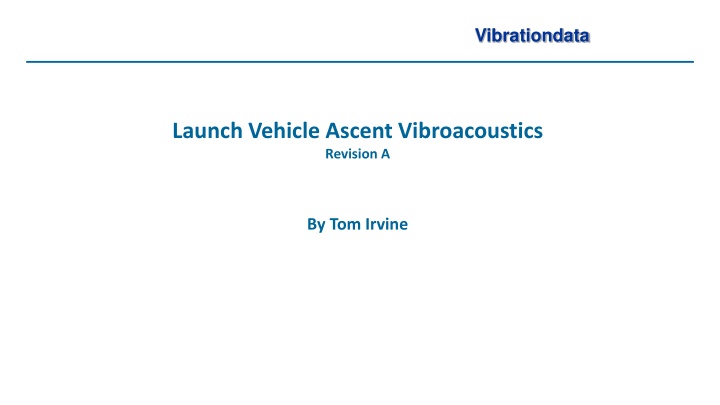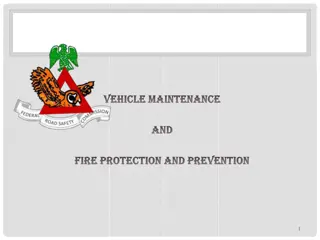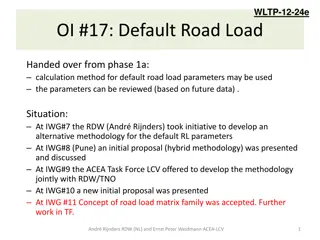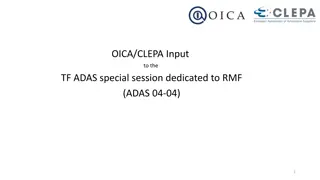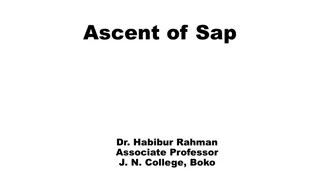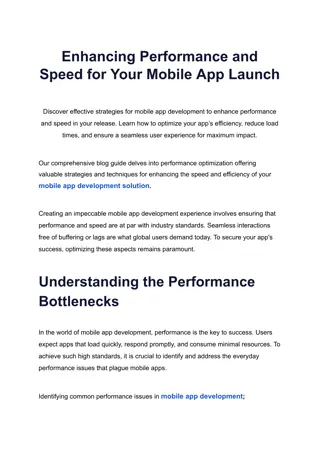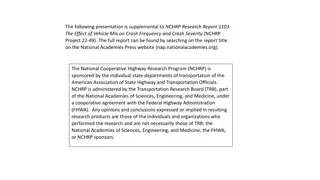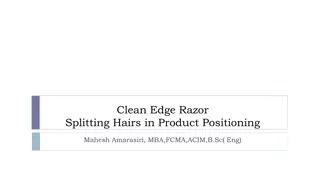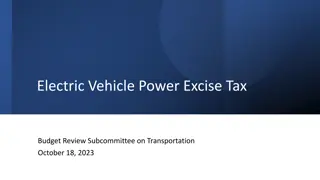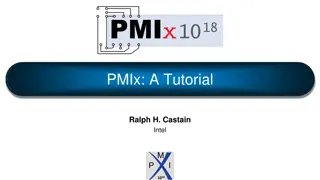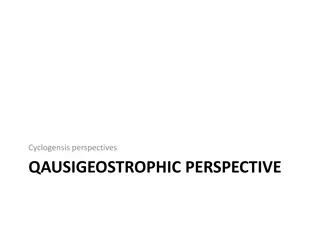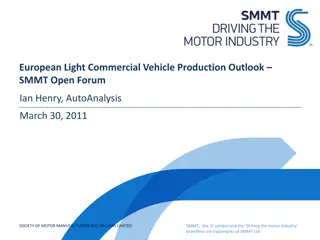Aeroacoustic Analysis of Launch Vehicle Ascent Dynamics
Investigate the vibroacoustics of launch vehicle ascent, focusing on the formation of turbulent boundary layers, aerodynamic excitation sources, and dynamic pressure coefficients. Learn about the transition to turbulent flow, shockwave formation, and the analysis steps involved in determining vibration responses to fluctuating pressure. Explore empirical methods for calculating aerodynamic pressure power spectral density along a rocket vehicle body for various flow regimes.
Download Presentation

Please find below an Image/Link to download the presentation.
The content on the website is provided AS IS for your information and personal use only. It may not be sold, licensed, or shared on other websites without obtaining consent from the author.If you encounter any issues during the download, it is possible that the publisher has removed the file from their server.
You are allowed to download the files provided on this website for personal or commercial use, subject to the condition that they are used lawfully. All files are the property of their respective owners.
The content on the website is provided AS IS for your information and personal use only. It may not be sold, licensed, or shared on other websites without obtaining consent from the author.
E N D
Presentation Transcript
Vibrationdata Launch Vehicle Ascent Vibroacoustics Revision A By Tom Irvine
Vibrationdata Flow Progression over Flat Plate Unsteady eddies form in turbulent boundary layer due to viscous and compressibility effects The transition from laminar to turbulent boundary layer occurs at locations where the Reynolds number 500,000 But my occur at lower Reynold numbers due to surface roughness
Vibrationdata Schlieren Photo, Wind Tunnel Test Wind tunnel testing in June 2006, on a partial model of the Ares I launch vehicle Included a portion of the upper stage, the spacecraft adapter, the Orion crew module and launch abort system The photo shows shock and expansion waves
Vibrationdata Ascent Excitation Sources Rocket vehicles are subjected to aerodynamic pressure excitation as they ascend in the atmosphere The excitation sources include aerodynamic shockwaves, turbulent boundary layers, and recirculating flow The excitation pressure fluctuates, with a broadband random characteristic Shockwaves begin to form along the rocket body as the vehicle approaches and surpasses the transonic velocity The local airflow must follow the geometry of the vehicle Thus the local airflow reaches supersonic speed before the vehicle center-of-gravity reaches supersonic speed The excitation is also severe as the vehicle encounters its maximum dynamic pressure condition These slides present empirical methods for determining the aerodynamic pressure power spectral density at stations along a rocket vehicle body for various flow regimes
Vibrationdata Analysis Steps Determine flow type Identify altitude, air density, speed of sound, free stream velocity, Mach number, dynamic pressure, Reynolds number, etc. Calculate pressure rms against vehicle external skin Calculate broadband fluctuating pressure PSD Calculate vibration response to fluctuating pressure PSD using Barrett scaling, Franken method, Statistical Energy Analysis (SEA), etc.
Vibrationdata Apollo Era Aeroacoustic Dynamic Pressure Coefficients The dynamic pressure q is 1 2 = q U 2 where U is the free stream velocity is the mass density P rmsis the fluctuating pressure level against the vehicle s surface Wilby methods also factor in Mach number, wall temperature, etc. Chandiramani, K. L., Widnall, S. E., Lyon, R. H., Franken, P. A., "Structural Response to Inflight Acoustic and Aerodynamic Environments", Bolt Beranek and Newman Report 1417, July 1967.
Vibrationdata Flow Regimes, 1 Cone-Cylinder Geometry, Subsonic, Shoulder Separation Cone-Cylinder Geometry, Transonic Shockwave Oscillation with Attached Flow
Vibrationdata Flow Regimes, 2 Cone-Cylinder Geometry, Supersonic, Attached Flow Cone-Cylinder Geometry with Separated Flow near Compression Corner, Subsonic
Vibrationdata Flow Regimes, 3 Cone-Cylinder Geometry with Separated Flow near Compression Corner and Shockwaves, Supersonic Shoulder and Boattail Induced Separation, Subsonic
Vibrationdata Flow Regimes, 4 Attached Flow with Boattail Induced Separation and Shockwave Oscillation, Supersonic
Vibrationdata Attached Flow, Pressure RMS The pressure RMS for attached boundary layer flow is Mach number is related to the free stream velocity by p . 0 010 rms = U q F = M c where wherecis the speed of sound ( ) T T w 2 2 = + + + F 0.5 0.5 0.09M 0.04M aw Typical simplifying assumption Mis the Mach number = T T Tw is the wall temperature w 1 aw Taw is the adiabatic wall temperature
Vibrationdata Attached Flow, Pressure PSD The pressure power spectral density G(f) for attached flow is 9 2 + . 0 475 M 2 . 1 433 p * U F rms 7 2 . 0 ( ) ( ) f = = . 0 0371 R G 4 ) ( ex . 0 64 2 * . 2 867 2 x q 2 + q 1 F + 1 . 0 13 M U x where f = frequency = Rex U 2 f * = The boundary layer thickness is the thickness for which U = 0.99 U * = boundary layer displacement thickness Rex = Reynolds number based on distance x The displacement thickness * is the thickness in a frictionless flow that would yield the same mass flow rate in a viscous flow x = distance from the start of boundary layer growth = kinematic viscocity
Vibrationdata Separated Flow & Shock Waves, Compression Corner p . 0 025 rms q = Ccomp= 3 Compression Corner Plateau Region, Transonic Flow 2 + 1 M comp p Ccomp= . 0 10 9 rms q Compression Corner Reattachment Region, Transonic Flow = 2 + 1 M comp 2 . 1 433 p U F rms ( ) f Compression Corner Pressure PSD = G 4 comp C ( ) 2 * . 2 867 2 2 q + q 1 comp C F comp Ccompis needed to account for a low frequency shift of energy for separated flow and shockwaves
Vibrationdata Separated Flow & Shock Waves, Expansion Corner p . 0 040 rms q Cexp= 3 Expansion Corner Plateau Region, Transonic and Supersonic Flow = 2 + 1 M exp Expansion Corner Reattachment Region, Transonic Flow p . 0 16 rms q Cexp= 9 = 2 + 1 M exp 2 1.433 p rms U 2 * q F ( ) = Expansion Corner Pressure PSD G f 4 Cexp 2 ( ) q 2.867 2 + 1 C F exp exp
Vibrationdata Further Reading Additional cases are given in: T. Irvine, Prediction of Sound Pressure Levels on Rocket Vehicles during Ascent, Revision D, Vibrationdata, 2007.
Vibrationdata References Wilby, J. and Wilby E., Prediction of External Fluctuating Pressure Field on Taurus During Ascent, AARC Report No. 131, Van Nuys, California, 1991 Laganelli, A.L., Howe, J.R., "Prediction of Pressure Fluctuations Associated with Maneuvering Re-Entry Weapons," AFFDL-TR-77-59, Vol I, July 1977 Incropera and DeWitt, Fundamentals of Heat Transfer, Wiley, New York, 1981 Laganelli, A.L., Wolfe, H.F., "Prediction of Fluctuating Pressure in Attached and Separated Turbulent Boundary Layer Flow," AIAA Paper AIAA- 89-1064, April 1989 Robertson, J.E., "Prediction of In-Flight Fluctuation Pressure Environments Including Protuberance Induced Flow," Wyle Laboratories Report WR 71-10, March 1971 Beranek, L. and Ver, I., editors, Noise and Vibration Control Engineering, Principles and Applications, Wiley, New York, 1992. See Chapter 14, Howe M., and Baumann H., Noise of Gas Flows Training Slides, VA One Vibroacoustics Software Package, ESI Group, 2011
Vibrationdata Vibration Calculation Calculate vibration response to fluctuating pressure PSD using Barrett scaling, Franken method, Statistical Energy Analysis (SEA), etc. Barrett & Franken will be covered in this slide presentation, both NASA methods SEA will be covered in a future presentation Use Barrett method if you already have reference pressure and acceleration PSD data from one of your own vehicles Otherwise, use Franken which comes with its own reference data
Vibrationdata Barrett Method, Empirical Scaling Extrapolation from reference vehicle to new vehicle NASA/TM-2009-215902, Using the Saturn V and Titan III Vibroacoustic Databanks for Random Vibration Criteria Development, 2009 Mass ratios should be squared per Newton s law But taking mass ratios to first power gives better agreement with measured data
Vibrationdata Franken, Empirical Scaling VIBRATION RESPONSE OF CYLINDRICAL SKIN TO ACOUSTIC PRESSURE NASA CR-1302, Summary of Random Vibration Prediction Procedures, 1969 -110 ACCELERATION LEVEL RE 1 GRMS + 20 LOG10 W - SPL (dB) Upper Limit Lower Limit -115 -120 NASA-HDBK-7005, Dynamic Environmental Criteria, 2001 -125 -130 The function was developed from studies of Jupiter and Titan I acoustic and radial skin vibration data collected during static firings -135 -140 The function predicts the skin vibration level in GRMS based on the input sound pressure level in dB, vehicle diameter in feet, and surface weight density in pounds per square foot -145 -150 -155 100 1000 5000 10000 50000 BAND CENTER FREQUENCY TIMES VEHICLE DIAMETER ( Hz feet)
Vibrationdata Franken Assumptions All flight vehicles to which the procedure is applied have similar dynamic characteristics to the Jupiter and Titan I vehicles Vibration is due to the acoustic noise during liftoff or other pressure fields during flight which can be estimated The vibration magnitude is directly proportional to the pressure level of the excitation and inversely proportional to the surface weight density of the structure. Predominant vibration frequencies are inversely proportional of the diameter of the vehicle Spatial variations in the vibration can be considered as a random variable
Vibrationdata Ring Frequency Consider a thin ring with a rectangular cross section and with completely free boundary conditions The ring frequency corresponds to the mode in which all points move radially outward together and then radially inward together This is the first extension mode, analogous to a longitudinal mode in a rod The ring frequency is the frequency at which the longitudinal wavelength in the skin material is equal to the vehicle circumference The ring frequency f ris The ring frequency is an idealized concept for a cylindrical shell C L d r= f In practice, cylindrical shells tend to have a high modal density near the ring frequency CL is longitudinal wave speed d is diameter
Vibrationdata Example A launch vehicle forward module is aluminum with 72 inch diameter Calculate its ring frequency Derive the fluctuating pressure level at a point on the module which is 240 inches from aft of the nose tip Also estimate the vibration level using the Franken method The common approach would be to consider a family of Mach case from, say, Mach 1 to Mach 1.8, including max-q, and then take a maximum envelope of the pressure level For simplicity, consider these three cases Alt (ft) Mach 22000 1.0 24000 1.1 26000 1.2
Make this array in Matlab Command Window >> trajectory=[22000 1.0; 24000 1.1; 26000 1.2]
Vibrationdata Maximum FPL at Mach 1.1 A fluctuating pressure level is conceptually similar to a sound pressure level Fluctuating is used to emphasize convection flow- induced Typically, 3 dB or some other uncertainty factor is added But none is added to FPL in this plot Q is dynamic pressure, C is speed of sound, OAFPL is overall FPL Alt (ft) Mach Q C (ft/sec) OAFPL (dB) (psf) 22000 1.0 626.4 1028.6 149.1 24000 1.1 695.6 1020.2 149.2 26000 1.2 758 1011.8 149.1
Vibrationdata Franken Method Results Again, add some uncertainty factor Final component test level should also envelope minimum workmanship level
